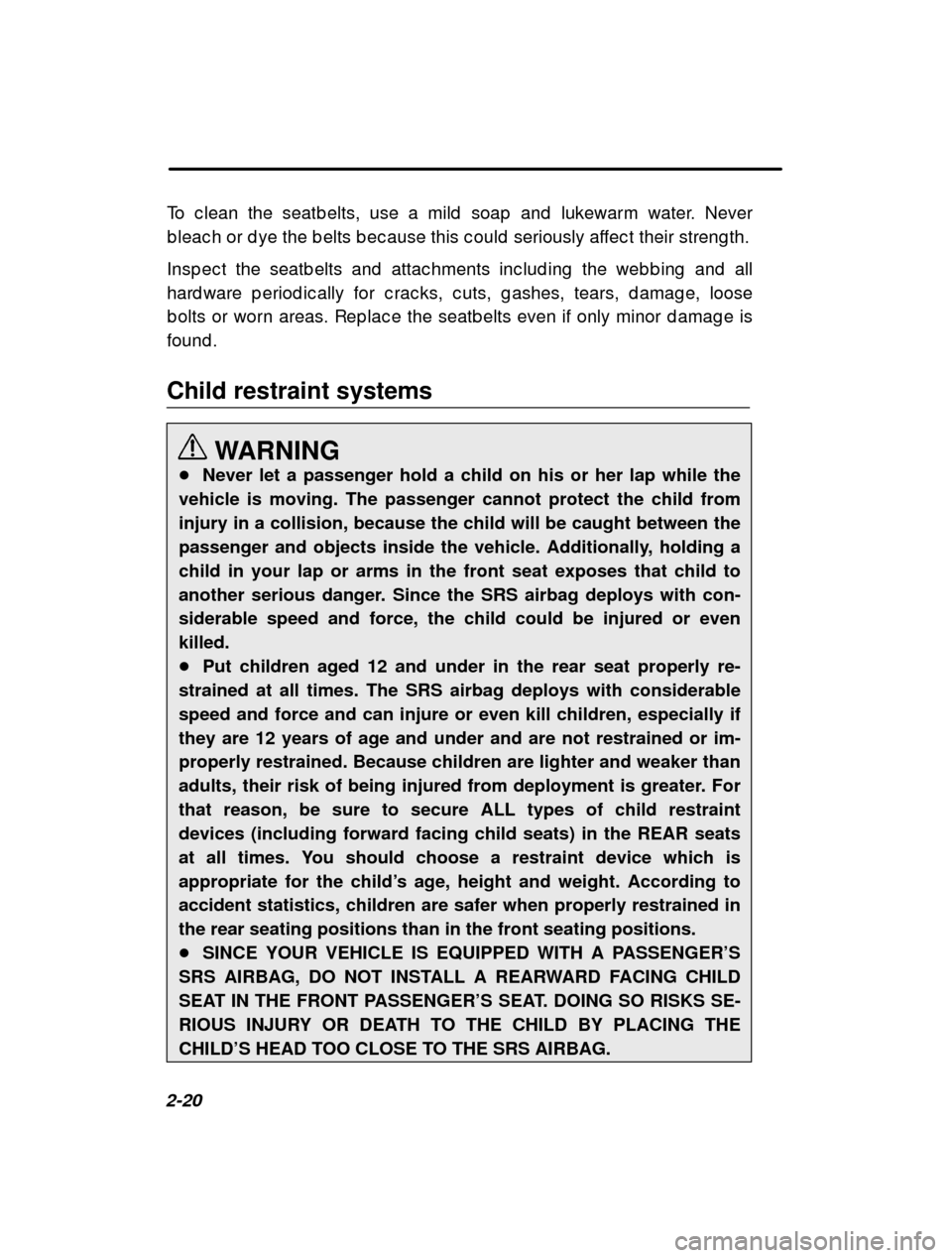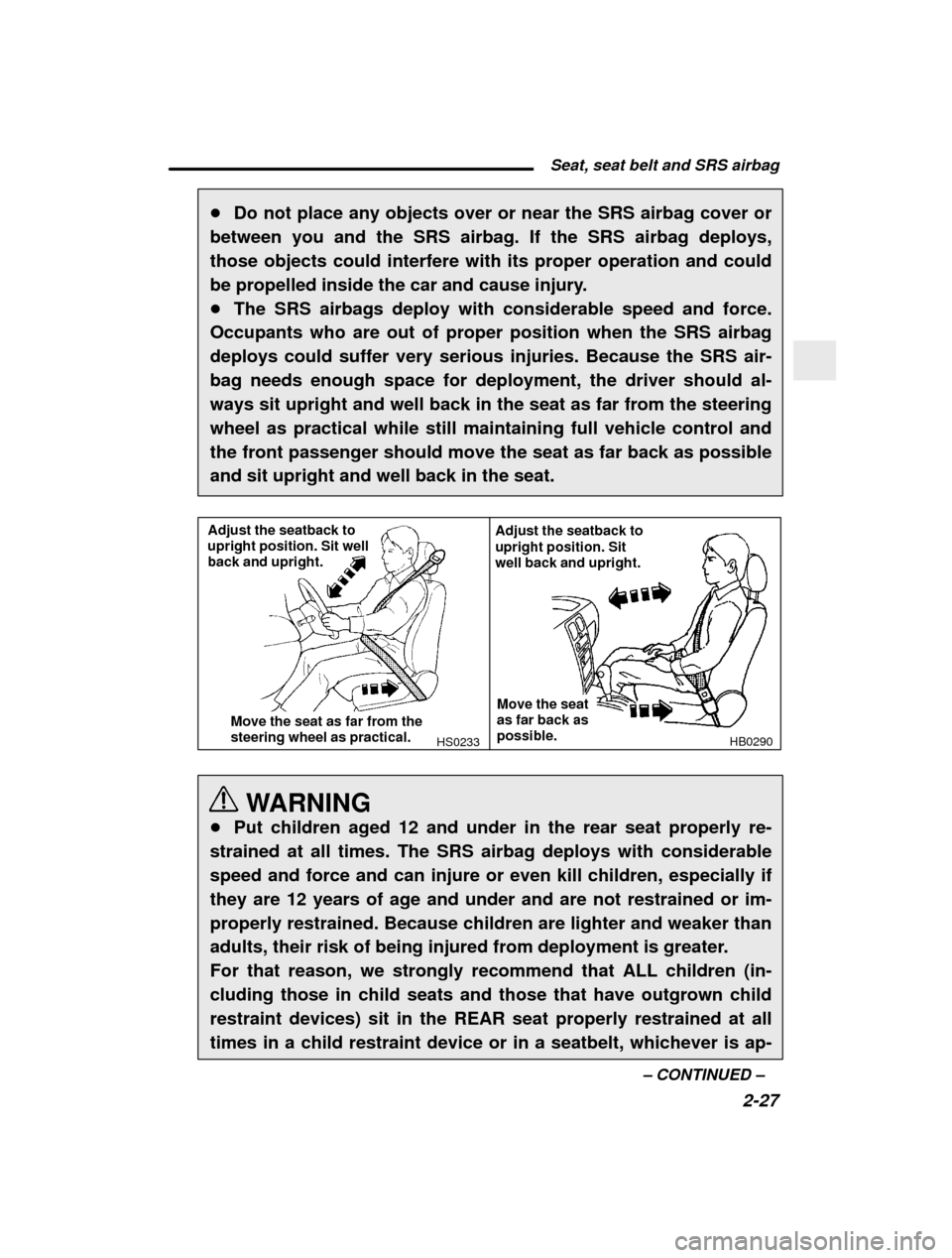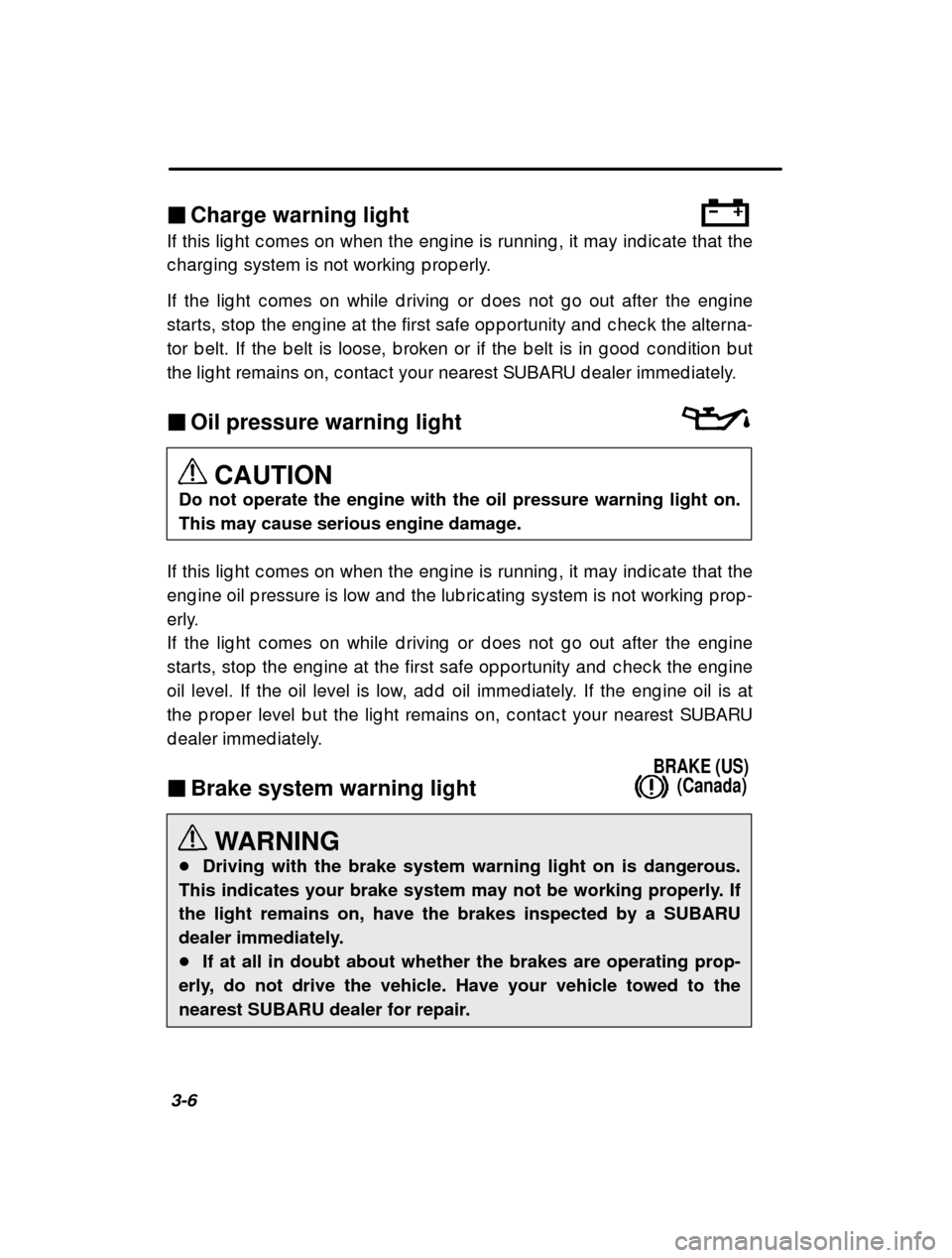2000 SUBARU IMPREZA warning light
[x] Cancel search: warning lightPage 75 of 320

2-20To c lean the seatb elts, use a mild soap and lukewar
m water. Never
b leac h or d ye the b elts b ec ause this c ould seriousl y affec t their streng th.
Insp ec t the seatb elts and attac hments inc lud ing the web b ing and all
hard ware p eriod ic ally for c rac ks, c uts, g ashes, tea rs, d amag e, loose
b olts or worn areas. Rep lac e the seatb elts even if only minor d amag e is
found .
Child restraint systems
WARNING
� Never let a passenger hold a child on his or her lap while the
vehicle is moving. The passenger cannot protect the child from injury in a collision, because the child will be caught between the
passenger and objects inside the vehicle. Additionally, holding achild in your lap or arms in the front seat exposes that child to
another serious danger. Since the SRS airbag deploys with con-
siderable speed and force, the child could be injured or evenkilled.� Put children aged 12 and under in the rear seat properly re-
strained at all times. The SRS airbag deploys with considerablespeed and force and can injure or even kill children, especially ifthey are 12 years of age and under and are not restrained or im-properly restrained. Because children are lighter and weaker than
adults, their risk of being injured from deployment is greater. Forthat reason, be sure to secure ALL types of child restraint
devices (including forward facing child seats) in the REAR seats
at all times. You should choose a restraint device which isappropriate for the child ’s age, height and weight. According to
accident statistics, children are safer when properly restrained inthe rear seating positions than in the front seating positions.� SINCE YOUR VEHICLE IS EQUIPPED WITH A PASSENGER ’S
SRS AIRBAG, DO NOT INSTALL A REARWARD FACING CHILD
SEAT IN THE FRONT PASSENGER ’S SEAT. DOING SO RISKS SE-
RIOUS INJURY OR DEATH TO THE CHILD BY PLACING THE
CHILD’ S HEAD TOO CLOSE TO THE SRS AIRBAG.
Page 82 of 320

Seat, seat belt and SRS airbag2-27
–
CONTINUED –
�
Do not place any objects over or near the SRS airbag cover or
between you and the SRS airbag. If the SRS airbag deploys, those objects could interfere with its proper operation and could
be propelled inside the car and cause injury.� The SRS airbags deploy with considerable speed and force.
Occupants who are out of proper position when the SRS airbag
deploys could suffer very serious injuries. Because the SRS air-bag needs enough space for deployment, the driver should al-ways sit upright and well back in the seat as far from the steeringwheel as practical while still maintaining full vehicle control and
the front passenger should move the seat as far back as possibleand sit upright and well back in the seat.
HS0233
Adjust the seatback to upright position. Sit well back and upright.
Move the seat as far from the steering wheel as practical.HB0290
Adjust the seatback to upright position. Sit well back and upright.
Move the seat as far back as possible.
WARNING
� Put children aged 12 and under in the rear seat properly re-
strained at all times. The SRS airbag deploys with considerable speed and force and can injure or even kill children, especially ifthey are 12 years of age and under and are not restrained or im-properly restrained. Because children are lighter and weaker than
adults, their risk of being injured from deployment is greater.
For that reason, we strongly recommend that ALL children (in-cluding those in child seats and those that have outgrown child
restraint devices) sit in the REAR seat properly restrained at alltimes in a child restraint device or in a seatbelt, whichever is ap-
Page 91 of 320

2-36�
SRS airbag system monitors
HG0341
SRS airbag system warning light
A d iag nostic system c ontinually monitors the read in
ess of the SRS air-
b ag system while the vehic le is b eing d riven. The S RS airb ag system
warning lig ht “AIRBAG ” will show normal system op eration b y lig hting for
ab out 6 sec ond s when the ig nition key is turned to the “ON ” p osition.
The following c omp onents are monitored b y the ind ic ator:
� Front sub sensor (Rig ht hand sid e)
� Front sub sensor (Left hand sid e)
� Airb ag c ontrol mod ule (inc lud ing imp ac t sensors)
� Airb ag mod ule (Driver ’s sid e)
� Airb ag mod ule (Passeng er ’s sid e)
� All related wiring
In the event of a malfunc tion ind ic ated b y any of f ollowing , the vehic le
should b e taken p romp tly to your nearest SUBARU d ea ler to have the
system c hec ked . Unless c hec ked and rep aired , the SR S airb ag s will not
func tion reliab ly: � Flashing or flic kering of the ind ic ator lig ht.
� No illumination of the warning lig ht when the ig nit ion switc h is first
turned to the “ON ” p osition.
� Continuous illumination of the warning lig ht.
� Illumination of the warning lig ht while d riving .
Page 95 of 320

3
Instruments and controls Gauges3-2
. . . . . . . . . . . . . . . . . . . . . . . . . . . . . . . . . . . . . . . . . . . . . . . . . . . . . . . . . . . . . . . . . . . . . . .
Speedometer 3-2
. . . . . . . . . . . . . . . . . . . . . . . . . . . . . . . . . . . . . . . . . . . . . . . . . . . . . . . . . . . . .
Odometer/Trip meter 3-2
. . . . . . . . . . . . . . . . . . . . . . . . . . . . . . . . . . . . . . . . . . . . . . . . . . . .
Tachometer (if equipped) 3-3
. . . . . . . . . . . . . . . . . . . . . . . . . . . . . . . . . . . . . . . . . . . . . .
Fuel gauge 3-3
. . . . . . . . . . . . . . . . . . . . . . . . . . . . . . . . . . . . . . . . . . . . . . . . . . . . . . . . . . . . . . . .
Temperature gauge 3-4
. . . . . . . . . . . . . . . . . . . . . . . . . . . . . . . . . . . . . . . . . . . . . . . . . . . . .
Warning and indicator lights 3-5 . . . . . . . . . . . . . . . . . . . . . . . . . . . . . . . . . . . . . . . . . .
Seat belt warning light and chime 3-5 . . . . . . . . . . . . . . . . . . . . . . . . . . . . . . . . . . . .
SRS airbag system warning light 3-5 . . . . . . . . . . . . . . . . . . . . . . . . . . . . . . . . . . . . .
Charge warning light 3-6
. . . . . . . . . . . . . . . . . . . . . . . . . . . . . . . . . . . . . . . . . . . . . . . . . . . .
Oil pressure warning light 3-6
. . . . . . . . . . . . . . . . . . . . . . . . . . . . . . . . . . . . . . . . . . . . .
Brake system warning light 3-6
. . . . . . . . . . . . . . . . . . . . . . . . . . . . . . . . . . . . . . . . . . . .
CHECK ENGINE warning light/Malfunction indicator lamp 3-7 . . . . . .
ABS warning light (for vehicles with ABS) 3-8 . . . . . . . . . . . . . . . . . . . . . . . . .
AT OIL TEMPerature warning light (for AT vehicles) 3-9 . . . . . . . . . . . . . .
Door open warning lights 3-10
. . . . . . . . . . . . . . . . . . . . . . . . . . . . . . . . . . . . . . . . . . . . . .
Front-wheel drive warning light (for AWD AT vehicles) 3-10 . . . . . . . . . .
Turn signal indicator lights 3-10
. . . . . . . . . . . . . . . . . . . . . . . . . . . . . . . . . . . . . . . . . . . .
High beam indicator 3-10
. . . . . . . . . . . . . . . . . . . . . . . . . . . . . . . . . . . . . . . . . . . . . . . . . . . . .
Low fuel warning light 3-10
. . . . . . . . . . . . . . . . . . . . . . . . . . . . . . . . . . . . . . . . . . . . . . . . . .
Clock 3-11
. . . . . . . . . . . . . . . . . . . . . . . . . . . . . . . . . . . . . . . . . . . . . . . . . . . . . . . . . . . . . . . . . . . . . . . . . .
Hazard warning flasher 3-11
. . . . . . . . . . . . . . . . . . . . . . . . . . . . . . . . . . . . . . . . . . . . . . . . .
Light control switch 3-12
. . . . . . . . . . . . . . . . . . . . . . . . . . . . . . . . . . . . . . . . . . . . . . . . . . . . . .
Turn signal lever 3-14
. . . . . . . . . . . . . . . . . . . . . . . . . . . . . . . . . . . . . . . . . . . . . . . . . . . . . . . . . .
Illumination brightness control 3-15 . . . . . . . . . . . . . . . . . . . . . . . . . . . . . . . . . . . . . .
Parking light switch 3-15
. . . . . . . . . . . . . . . . . . . . . . . . . . . . . . . . . . . . . . . . . . . . . . . . . . . . . .
Fog light switch (if equipped) 3-16 . . . . . . . . . . . . . . . . . . . . . . . . . . . . . . . . . . . . . . . .
Wiper and washer 3-16
. . . . . . . . . . . . . . . . . . . . . . . . . . . . . . . . . . . . . . . . . . . . . . . . . . . . . . . .
Windshield wipers and washer switches 3-18 . . . . . . . . . . . . . . . . . . . . . . . . . . .
Rear window wiper and washer switch (if equipped) 3-20 . . . . . . . . . . . . .
Rear window defogger switch 3-21 . . . . . . . . . . . . . . . . . . . . . . . . . . . . . . . . . . . . . . . .
Horn 3-22
. . . . . . . . . . . . . . . . . . . . . . . . . . . . . . . . . . . . . . . . . . . . . . . . . . . . . . . . . . . . . . . . . . . . . . . . . . .
Mirrors 3-22
. . . . . . . . . . . . . . . . . . . . . . . . . . . . . . . . . . . . . . . . . . . . . . . . . . . . . . . . . . . . . . . . . . . . . . . .
Inside mirror 3-22
. . . . . . . . . . . . . . . . . . . . . . . . . . . . . . . . . . . . . . . . . . . . . . . . . . . . . . . . . . . . . .
Outside mirrors 3-23
. . . . . . . . . . . . . . . . . . . . . . . . . . . . . . . . . . . . . . . . . . . . . . . . . . . . . . . . . .
Page 99 of 320

Instruments and controls3-5
–
CONTINUED –
Warning and indicator lights
Several of the warning and ind ic ator lig hts c ome on
momentarily and
then g o out when the ig nition switc h is initially t urned to the “ON ” p osi-
tion. This p ermits c hec king the op eration of the b u lb s.
Ap p ly the p arking b rake and turn the ig nition switc h to the “ON ” p osition.
The following lig hts c ome on:
Seat b elt warning lig ht
SRS airb ag system warning lig ht
Charg e warning lig ht
Oil p ressure warning lig ht
Brake system warning lig ht
CHECK ENGINE warning lig ht/Malfunc tion ind ic ator la mp
ABS warning lig ht (if eq uip p ed )
AT OIL TEMPerature warning lig ht (if eq uip p ed )
If any lig hts fail to c ome on, it ind ic ates a b urne d -out b ulb or a malfunc -
tion of the c orresp ond ing system.
Consult your authorized SUBARU d ealer for rep air. � Seat belt warning light and chime
When the ig nition switc h is turned to the “ON ” p osition, the seat b elt
warning lig ht will c ome on and the remind er c hime will sound to remind
d river to fasten the seat b elt.
The seat b elt warning lig ht will remain on for ab ou t six sec ond s and turn
off automatic ally after six sec ond s.
The seat b elt remind er c hime will turn off when the d river’s sid e seat b elt
is b uc kled or it will turn off automatic ally after six sec ond s.
� SRS airbag system warning light AIRBAG
When the ig nition switc h is turned to the “ON ” p osition, the SRS airb ag
warning lig ht will c ome on for ab out six sec ond s an d g o out. This shows
the SRS airb ag is in normal op eration.
If this lig ht c omes on while d riving or d oes not g o out after the eng ine
starts, it may ind ic ate that the SRS airb ag system is not working p rop erly.
Contac t your nearest SUBARU d ealer immed iately.
Page 100 of 320

3-6
�
Charge warning light
If this lig ht c omes on when the eng ine is running , it may ind ic ate that the
c harg ing system is not working p rop erly.
If the lig ht c omes on while d riving or d oes not g o out after the eng ine
starts, stop the eng ine at the first safe op p ortuni ty and c hec k the alterna-
tor b elt. If the b elt is loose, b roken or if the b e lt is in g ood c ond ition b ut
the lig ht remains on, c ontac t your nearest SUBARU d ealer immed iately.
� Oil pressure warning light
CAUTION
Do not operate the engine with the oil pressure warning light on. This may cause serious engine damage.
If this lig ht c omes on when the eng ine is running , it may ind ic ate that the
eng ine oil p ressure is low and the lub ric ating syst em is not working p rop -
erly.
If the lig ht c omes on while d riving or d oes not g o out after the eng ine
starts, stop the eng ine at the first safe op p ortuni ty and c hec k the eng ine
oil level. If the oil level is low, ad d oil immed ia tely. If the eng ine oil is at
the p rop er level b ut the lig ht remains on, c ontac t your nearest SUBARU
d ealer immed iately. � Brake system warning light
WARNING
� Driving with the brake system warning light on is dangerous.
This indicates your brake system may not be working properly. If the light remains on, have the brakes inspected by a SUBARU
dealer immediately.� If at all in doubt about whether the brakes are operating prop-
erly, do not drive the vehicle. Have your vehicle towed to the
nearest SUBARU dealer for repair.
(Canada)
BRAKE (US)
Page 101 of 320

Instruments and controls3-7
–
CONTINUED –
This lig ht has the following two func tions:
�Parking brake warning
The lig ht c omes on with the p arking b rake ap p lied w hile the ig nition
switc h is in the “ON ” p osition. It g oes out when the p arking b rake is
fully released . � Brake fluid level warning
This lig ht c omes on when the b rake fluid level d rop s to near the “MIN ”
level of the b rake fluid reservoir with the ig nitio n switc h in the “ON ”
p osition and with the p arking b rake fully released .
If the b rake system warning lig ht should c ome on wh ile d riving with
the p arking b rake lever fully released , it c ould b e an ind ic ation of
leaking of b rake fluid or worn b rake p ad s. In suc h a c ase, have your
vehic le c hec ked b y a SUBARU d ealer immed iately.
� CHECK ENGINE warning light/ Malfunction indicator lamp
CAUTION
If the CHECK ENGINE light comes on while you are driving, have
your vehicle checked/repaired by your SUBARU dealer as soonas possible. Continued vehicle operation without having the
emission control system checked and repaired as necessarycould cause serious damage, which may not be covered by your
vehicle’ s warranty.
If this lig ht c omes on stead ily or b links while the eng ine is running , it may
ind ic ate that there is a p rob lem or p otential p rob l em somewhere in the
emission c ontrol system.
� If the light comes on steadily:
If the lig ht c omes on stead ily while d riving or d oe s not g o out after the
eng ine starts, an emission c ontrol system malfunc ti on has b een d e-
tec ted .
You should have your vehic le c hec ked b y an authoriz ed SUBARU
d ealer immed iately.
Page 102 of 320

3-8NOTE This light also comes on when the fuel filler cap is not tightened until it clicks. If you have recently refueled your vehicle, the
cause of the CHECK ENGINE warning light/malfunction indicatorlamp coming on could be a loose or missing fuel filler cap.Remove the cap and retighten it until it clicks. Make sure nothing
is interfering with the sealing of the cap. Tightening the cap will
not make the CHECK ENGINE warning light turn off immediately.It may take several driving trips. If the light does not go out, take
your vehicle to your authorized SUBARU dealer immediately. �
If the light is blinking:
If the lig ht is b linking while d riving , an eng ine m isfire c ond ition has
b een d etec ted whic h may d amag e the emission c ontrol system.
To p revent serious d amag e to the emission c ontrol s ystem, you
should d o the following : � Red uc e vehic le sp eed .
� Avoid hard ac c eleration.
� Avoid steep up hill g rad es.
� Red uc e the amount of c arg o, if p ossib le.
� Stop towing a trailer as soon as p ossib le.
The CHECK ENGINE warning lig ht may stop b linking an d c ome on
stead ily after several d riving trip s. You should ha ve your vehic le
c hec ked b y an authorized SUBARU d ealer immed iately.
� ABS warning light (for vehicles with ABS)
The ABS warning lig ht c omes on when the ig nition sw itc h is turned to the
“ ON ” p osition and g oes out after ab out two sec ond s.
This is an ind ic ation that the ABS system is workin g p rop erly.
If the warning lig ht b ehaves as follows, the ABS sy stem may not work
p rop erly.� The warning lig ht d oes not c ome on when the ig nitio n switc h is turned
to the “ON ” p osition.
� The warning lig ht c omes on when the ig nition switc h is turned to the
“ ON ” p osition, b ut it d oes not g o out even when the veh ic le sp eed
(U.S.)
(Canada)
ABS